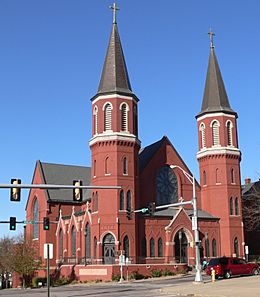Cathedral of the Epiphany (Sioux City, Iowa) facts for kids
Quick facts for kids Cathedral of the Epiphany |
|
|---|---|
 |
|
| 42°30′03″N 96°24′25″W / 42.5009°N 96.4070°W | |
| Location | 1000 Douglas St. Sioux City, Iowa |
| Country | United States |
| Denomination | Roman Catholic Church |
| History | |
| Status | Cathedral/Parish |
| Founded | 1891 |
| Dedication | Epiphany |
| Architecture | |
| Architect(s) | Charles P. Brown |
| Style | Gothic Revival |
| Completed | 1904 |
| Specifications | |
| Number of spires | Two |
| Materials | Brick |
| Administration | |
| Diocese | Sioux City |
The Cathedral of the Epiphany is a beautiful church in Sioux City, Iowa, USA. It's a special kind of church called a cathedral, which means it's the main church for the Catholic area of Sioux City.
Contents
History of the Cathedral
Early Beginnings in Sioux City
The very first Catholic Mass in Sioux City happened in 1855. It was celebrated by Father Jeremiah Tracey in a simple log cabin. The Cathedral of the Epiphany started as St. Mary's Church in 1891. Father Timothy Treacy was the first leader of this church. It was built to help the many Irish and German Catholic families moving into the city.
However, building a new church was put on hold. This was because of a big economic problem in the United States in 1893. For the next ten years, people went to church in the basement of the building.
Becoming a Cathedral
In 1902, Pope Leo XIII created the Diocese of Sioux City. Bishop Philip Joseph Garrigan decided that St. Mary's Church would become the main church, or cathedral. He started working to finish the upper part of the church. He also asked for permission to change the church's name.
On September 8, 1904, Bishop Garrigan officially opened the building. It was named the Cathedral of the Epiphany. At this time, it did not yet have its tall spires.
Changes and Renovations
The cathedral had a small update in 1939. Then, in 1952, the two tall spires were finally added to the towers. In 1961, Bishop Joseph Maximilian Mueller started a big project. This project completely changed the inside of the cathedral. A new marble altar was put in, replacing the old wooden one. New furniture, paint, and lighting were also added.
In the 1980s, fewer people were attending the church. There was even talk of closing it. But then, many Catholic families from Latin America and Southeast Asia moved to the area. This helped the church grow again. Today, the church welcomes everyone. Masses are held in English, Spanish, Vietnamese, and Latin.
The most recent big renovation happened in 1994. This project fixed the roof, gutters, and outside walls. It also brought back many of the beautiful decorations inside that were removed in 1961. A generous gift of $1 million helped start the fundraising. The total cost for the inside changes was $3 million. An architect named Larry Ericsson helped design the changes. He wanted the church to look like it did in the early 1900s. The cathedral was officially reopened on November 10, 1998.
Cathedral Architecture
The Cathedral of the Epiphany is a great example of 19th-century German Gothic style. This style often features tall arches and detailed stonework.
Special Features Inside
- The baptismal font, where baptisms happen, was designed by a local architect named William L. Steele.
- The cathedral has 61 beautiful stained glass windows. These windows were made by Franz Mayer & Co. in Munich, Germany. They were carefully cleaned and repaired in the late 1980s.
- The decorative screen behind the main altar, called a reredos, came from another church. The side altars and the Stations of the Cross also came from the former St. Thomas Church. These items were given to the cathedral because they matched the original style.
- Many religious statues inside the church were carved and painted by hand in Italy.
The Pipe Organ
The cathedral has a large pipe organ built in 2006 by Orgelbau Wech. It is located in a special area at the back of the church. The organ has two keyboards and many different sounds, called stops. It has a total of 31 stops, which means it can make many different musical tones.
Parochial School History
Cathedral High School
In the 1940s, people at the church started talking about building a new school. The last class graduated from Cathedral High School on June 1, 1949. That fall, Bishop Heelan Catholic High School opened. The Sisters of Charity of the Blessed Virgin Mary, who taught at Cathedral High, continued to teach at Heelan.
Epiphany Grade School
By 1957, it was clear that both Epiphany and Heelan needed new school buildings. The diocese raised money and bought land for a new grade school. The new school opened in September 1959.
The parish grade school closed in 1987. This happened when schools from Epiphany, St. Boniface, and St. Joseph combined. They formed a new school called Holy Family School. The old school building is now called Epiphany Center. It holds offices, a parish center, and classrooms for religious education. The Epiphany Center also has the Cathedral Dual Language Academy for elementary students. This academy is part of Bishop Heelan Catholic Schools.
See also
 In Spanish: Catedral de la Epifanía (Sioux City) para niños
In Spanish: Catedral de la Epifanía (Sioux City) para niños

